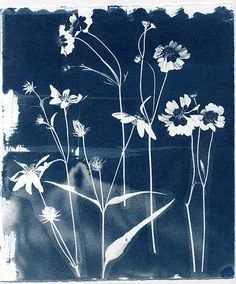Cyanotype Printing
What is Cyanotype Printing you ask? Cyanotype is a photographic printing process that produces a cyan-blue print. Engineers used the process well into the 20th century as a simple and low-cost process to produce copies of drawings, referred to as blueprints. The process uses two chemicals: ferric ammonium citrate and potassium ferricyanide.
The English scientist and astronomer Sir John Herschel discovered the procedure in 1842. Though the process was developed by Herschel, he considered it as mainly a means of reproducing notes and diagrams, as in blueprints.
Anna Atkins created a series of cyanotype limited-edition books that documented ferns and other plant life from her extensive seaweed collection, placing specimens directly onto coated paper and allowing the action of light to create a silhouette effect. By using this photogram process, Anna Atkins is sometimes considered the first female photographer. Cyanotype photography was popular in Victorian England but became less popular as photography improved.
Want to try this at home? ParallazPhoto Coop has a page on it, here. It certainly looks achievable at home, this is something I might have to try my hand at over the holiday break.
Of course, there are ways to achieve a similar result in post-processing; Nik Effects used to have something to replicate this (I don’t have the current version of Nik, so I am unsure if it is still there), Photo Exposure X3 and of course, there are ways to recreate in Photoshop as well.
Here is a link to a fabulous Pinterest Board full of images collected in 2019
This is NOT my image




